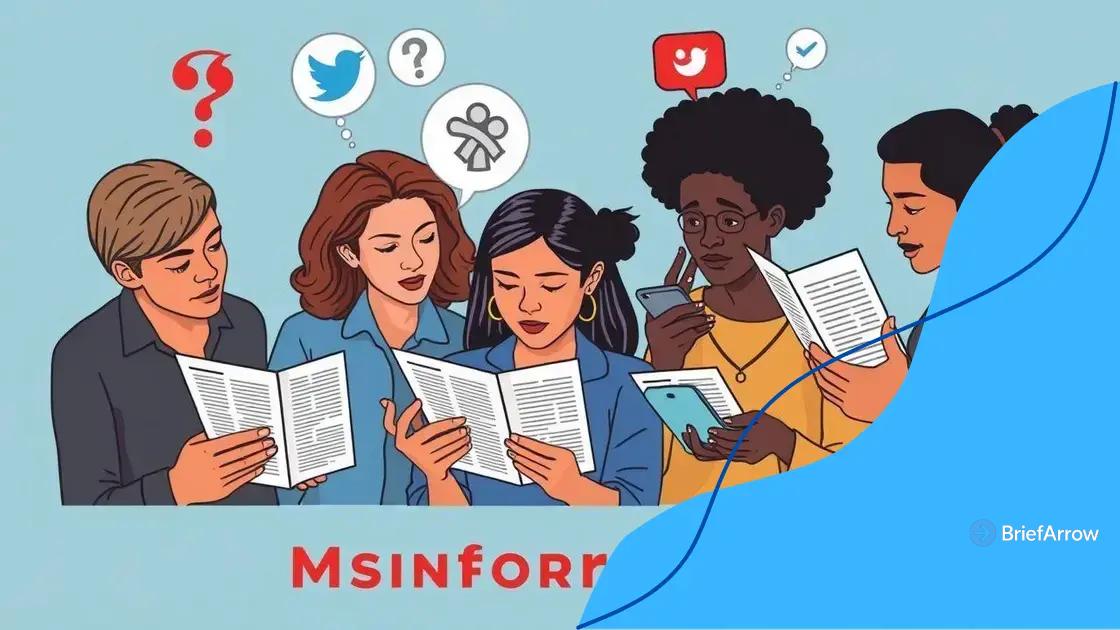Public trust in media organizations remains low: what now?

Anúncios
Public trust in media organizations remains low due to misinformation, lack of accountability, and the need for transparency and engagement strategies to rebuild relationships with audiences.
Public trust in media organizations remains low, and it’s a concern for many. Have you noticed how skepticism towards news outlets affects our understanding of important issues? Let’s explore this predicament further.
Anúncios
Understanding the current trust levels in media
Understanding how public trust in media organizations works is essential to navigate our information landscape. Recent studies show that many people feel uncertain about the news they consume.
Current Levels of Trust
According to surveys, trust levels vary significantly among different demographics. For example, younger audiences often exhibit lower trust in traditional media compared to older generations.
Factors Affecting Trust
Several factors contribute to how people perceive media reliability. These include:
Anúncios
- Consistency and transparency in reporting.
- Frequency of fact-checking and corrections.
- Responses to public criticism and misinformation.
When media organizations are open about their processes, it helps build a stronger bond with the audience. Trust is more easily achieved when the audience feels their concerns are addressed.
Distrust in Social Media
Social media platforms play a unique role in shaping public opinion. They often disseminate information faster, but this can lead to confusion. Sources that prioritize sensationalism over facts harm trust in media overall. Misinformation spreads rapidly, making it challenging for individuals to distinguish credible news.
Educational initiatives can counteract this issue. Encouraging media literacy from a young age is crucial to fostering a more discerning audience. By being equipped with the right skills, people can better evaluate the information presented to them.
Factors contributing to declining trust
Several factors are behind the declining trust in media organizations today. It’s essential to identify these elements to understand what is happening in the information landscape.
Misinformation and Fake News
One major factor is the prevalence of misinformation and fake news. With the rise of the internet, anyone can publish information without verification. This makes it hard for audiences to know what to believe.
Lack of Accountability
Another significant issue is the lack of accountability among media outlets. When organizations do not correct errors or respond to public backlash, they lose credibility. Trust is hard to rebuild once it is broken.
- Inconsistent reporting can confuse readers.
- Failure to fact-check before publishing compromises reliability.
- Publicized retractions can hurt an outlet’s image.
Moreover, sensationalism plays a role in eroding trust. When headlines prioritize clicks over facts, audiences feel manipulated. They start doubting the intention behind the news presented to them.
Political Polarization
Political polarization further complicates trust levels. Many people gravitate towards media that reflects their own beliefs. When audiences consume biased information, they turn away from unbiased sources.
Additionally, social media algorithms can exacerbate this issue. When users only see content that matches their viewpoints, their perception of trust becomes skewed. This can widen the gap between different audience segments.
How misinformation impacts public perception

Misinformation plays a critical role in shaping public perception of media organizations and the news they produce. When people encounter false information, it can lead to confusion and mistrust.
The Spread of Misinformation
Social media is a prime vehicle for the rapid spread of misinformation. Information can be shared widely before it is fact-checked. This can create a false narrative that many people believe to be true.
Effects on Trust
When misinformation is prevalent, trust in media organizations declines. Audiences find it challenging to differentiate between credible news and misleading stories. They might completely disengage from news sources they perceive as unreliable.
- People often rely on their social circles for information.
- Emotionally charged headlines grab attention, even if they are false.
- Fact-checking efforts can be overwhelmed by the amount of misinformation.
Moreover, once misinformation takes hold in public consciousness, it can be incredibly difficult to correct. Even after the truth is revealed, many individuals will still cling to their initial belief. This phenomenon is known as the “backfire effect,” where corrections may reinforce the original misinformation instead of dispelling it.
Importance of Media Literacy
To combat the effects of misinformation, it is crucial to promote media literacy. By equipping individuals with the skills to critically evaluate sources, we can reduce the impact of false information. Educational initiatives that teach how to identify credible news are essential.
Engaging in conversations about misinformation can also help shift public perception. When audiences feel empowered to question the information they consume, they are more likely to develop a healthier skepticism towards misleading narratives.
Strategies for media organizations to regain trust
For media organizations, developing effective strategies to regain trust is essential in today’s changing landscape. Understanding audience concerns is the first step in addressing these issues.
Improve Transparency in Reporting
One strategy is to enhance transparency in reporting processes. This includes providing clear sources for news stories and explaining how information is gathered.
Engage with the Audience
Another effective approach is to actively engage with the audience. Media organizations should open channels for feedback to understand public concerns better. By listening and responding, they can create a more trusting relationship.
- Host Q&A sessions to address public queries.
- Utilize social media to interact with followers.
- Conduct surveys to gather insights on audience perceptions.
Additionally, fostering a culture of accountability within the organization is vital. When mistakes happen, admitting errors promptly can help rebuild lost trust. Practicing consistent fact-checking and issuing corrections when needed shows commitment to accuracy.
Educate the Audience
Education is key to fostering critical thinking among the audience. Offering resources about media literacy can empower individuals to analyze news more effectively. This can reduce the spread of misinformation and enhance overall understanding of news value.
Furthermore, partnering with educational institutions can amplify these efforts. By working together, media organizations can build a more informed public, which ultimately benefits everyone.
The future of media and public engagement
The future of media and public engagement will likely evolve rapidly as technology continues to advance. As audiences demand more transparency and interactivity, media organizations must adapt to these expectations.
Evolving Platforms
New platforms are emerging constantly, changing the way news is consumed. People now prefer to get updates through social media, podcasts, and video content. Media organizations need to stay ahead by embracing these platforms and understanding their audiences’ preferences.
Greater Inclusivity
There is also a growing demand for greater inclusivity in the media. Audiences want to see diverse voices represented in news stories. This includes different cultural backgrounds, genders, and viewpoints. By embracing a broader range of perspectives, media can foster a deeper connection with their audience.
- Incorporating feedback from diverse communities.
- Highlighting stories from underrepresented groups.
- Creating content that resonates across various demographics.
Furthermore, the use of technology in engagement strategies is essential. Virtual reality (VR) and augmented reality (AR) are starting to play a significant role in how stories are told. These tools can create immersive experiences that draw the audience in, making them feel more connected to the news.
Crisis Communication
In times of crisis, media organizations must act swiftly and transparently to maintain trust. Providing real-time updates and reliable information builds confidence among audiences. Crisis communication plans are crucial for handling misinformation and keeping the public informed.
Ultimately, the media’s role is evolving from merely reporting news to becoming a collaborative space where audiences can participate. Engaging public participation in discussions will lead to a more informed and active citizenry.
FAQ – Frequently Asked Questions about Media Trust and Public Engagement
What role does transparency play in building trust in media?
Transparency helps build trust by allowing the audience to see how information is sourced and verified.
How can media organizations ensure inclusivity in their reporting?
By actively seeking diverse voices and perspectives to be included in news stories, media can resonate more with various audiences.
What technologies can enhance public engagement with media?
Technologies like virtual reality (VR) and augmented reality (AR) create immersive experiences that draw audiences into the news.
Why is audience feedback important for media organizations?
Audience feedback allows media to understand public concerns and improve content, fostering a stronger connection and trust.